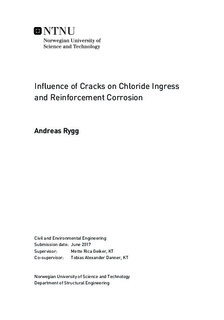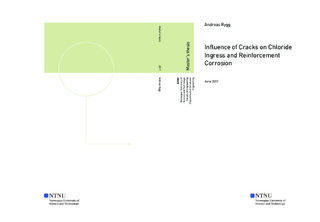| dc.description.abstract | Chloride induced reinforcement corrosion is a major durability problem in concrete constructions. It is consensus in literature that cracks facilitate chloride ingress, and may initiate early reinforcement corrosion. This study focuses on gathering more long-term data on the relation between cracks, chloride ingress and initiating of reinforcement corrosion.
Two bridges in Trondheim were investigated, Moholt Bridge and Cecilie Bridge. Moholt Bridge was half-cell potential mapped. Three cores were drilled from the bridge. One core with 0.55 mm crack width, one with 0.15 mm crack width and one reference core with no crack, all of them included reinforcement. One core was drilled from Cecilie Bridge. This core had a crack width of 0.45 mm and no reinforcement. They were chloride mapped using µ-XRF. Characterization of carbonation was done and the reinforcement was excavated and investigated.
The cores from Moholt Bridge all showed a similar chloride ingress, evenly distanced from the top surface and no additional chloride ingress around the crack and from the crack surface. The core from Cecilie Bridge showed a chloride ingress both from the top surface and from the crack surface. Both bridges are quite similar constructions, but interestingly they showed opposite results on chloride ingress through cracks.
Reinforcement corrosion was only detected in the core with crack width of 0.55 mm from Moholt Bridge. It was located on the reinforcement closest to the crack. There was not detected any chlorides in the crack, but the crack surface and parts of the concrete area around the reinforcement, was completely carbonated. This could indicate carbonation as the cause of the observed corrosion. The crack surface in the core from Cecilie Bridge was also carbonated, but there was no reinforcement to investigate in this core. | |

